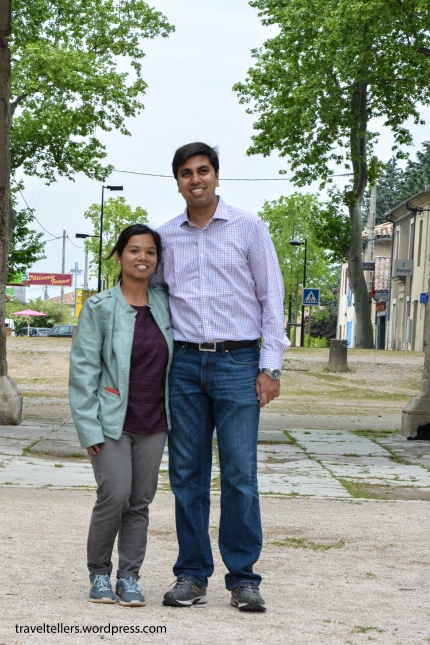Orange is a Roman town located about 20 km north of our base city of Avignon. The town has just one major monument – the antique theatre – but that monument certainly justifies and, dare I say, demands a visit to Orange. Well, who were we to ignore such a demand! Thus, on our fifth day in Provence, we scheduled a visit to Orange.
After two days of hectic travelling and monument hopping, we began our day a little later than usual. A train from Avignon Centre railway station took us to the Orange railway station in approximately 15 minutes. As soon as we reached Orange we were greeted with grey overcast sky which worried us a little as were not carrying umbrellas. From the railway station, a 1.5 km walk through the streets of Orange led us to our first monument of the day.
ARC DE TRIOMPHE D’ORANGE
The Triumphal Arch of Orange stands majestically in the centre of a large grassy square. The design of this Roman arch was quite different to all other arches we had seen till now (and we had seen quite a few). It had three arches rather than the usual single arch that we found everywhere. The arch in the centre was significantly larger than those on the sides. The monument carried some fine sculptures though most of them have been destroyed with time.

As we were observing the arch, a British gentleman approached us and offered to take our photos to which we happily agreed. He took some photos, we thanked him and he left without looking at the arch which made us wonder if he had come just to click our photos. With that we were done with the arch and left to visit the monument for which we had come all the way to Orange.

THÉÂTRE ANTIQUE D’ORANGE
Two days prior to our visit to Orange, we had visited Arles which had its own antique theatre but the one at Arles was almost in ruins and we could get an idea of the enormity of the structure only through our imaginations and a not-so-clear video. Well, this time we didn’t require any imagination as the entire monument stood before us in its full glory.
The antique theatre of Orange is one of the best preserved Roman theatres in the world. The exterior façade of the theatre is a gigantic wall that is 103 m long, 37 m high (equivalent to a 10 storey building) and 1.8 m thick and was described as the ‘finest wall in my kingdom’ by King Louis XIV of France. The interior of the theatre included the stage area, a three-tiered seating area, inner galleries and outer walls. The stage wall itself was huge with a length of 61 m and height of 37 m. Most of the sculptures and other decorations that must have adorned this wall have disappeared with time but we could still see a few columns, entry and exits doorways used by performers and a statue of Emperor Augustus.

After being awed by the stage area, we climbed the stairs of the seating area listening intently to our audioguide that explained the history of the theatre, restoration works that were carried out, kind of plays that happened in the theatre (comedies being the most dominant), the sound enhancing function of the stage wall, the seating arrangement as per social status and various other aspects of the monument. We climbed till the top of the seating area and were rewarded with excellent views of the theatre and surrounding areas.

From our vantage point up there we saw excavated ruins of a temple just next to the theatre. We climbed down to look at it from close but honestly there was nothing much to see in those excavations, especially when compared to our experience at Glanum the previous day.
After that our audioguide guided us to the inner galleries of the theatre to see “The Ghosts of the Theatre”. This was a collection of short shows playing in four different cave like rooms of the theatre. They depicted some of the famous shows that took place in the theatre from ancient times to modern era via multimedia. The shows were in French hence we didn’t understand the dialogues but what we saw left us fascinated. A couple of shows used holographic projections which made it look like the characters were actually there performing in front of us rather than on screen.
Our ticket also included a visit to the Museum of art and history which was located just opposite to the theatre. The museum contained many objects that have been found during various excavations in Orange. Some of the objects that decorated the theatre’s stage wall were also displayed here. Our visit to the museum was pretty short and not that interesting. After that we walked back to the station bringing our fifth day in Provence to an early end.
